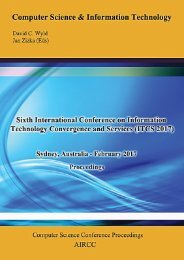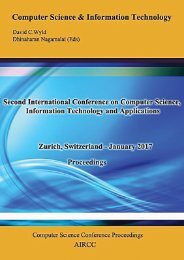CoSIT 2017
Fourth International Conference on Computer Science and Information Technology ( CoSIT 2017 ), Geneva, Switzerland - March 2017
Fourth International Conference on Computer Science and Information Technology ( CoSIT 2017 ), Geneva, Switzerland - March 2017
Create successful ePaper yourself
Turn your PDF publications into a flip-book with our unique Google optimized e-Paper software.
Computer Science & Information Technology (CS & IT) 43<br />
l<br />
k<br />
= arg max P(<br />
l | z , γ<br />
λ<br />
, Φλ<br />
)<br />
λ∈Ω<br />
s<br />
In practice, we assume that the fit error residuals follow a Gaussian distribution. As a result, the<br />
class label is that associated with the minimum squared error. This process is repeated for each<br />
stroke in turn. The class identity of the set of strokes is summarised the string of assigned strokelabels<br />
k<br />
(6)<br />
L =< l 1<br />
, l2,.....<br />
><br />
(7)<br />
Hence, the input layer is initialised using maximum likelihood stroke parameters and maximum a<br />
posteriori probability stroke labels.<br />
The shape-layer takes this information as input. The goal of computation in this second layer is to<br />
refine the configuration of stroke labels using global constraints on the arrangement of strokes to<br />
form consistent shapes. The constraints come from both geometric and symbolic sources. The<br />
geometric constraints are provided by the fit of a stroke-centre point distribution model. The<br />
symbolic constraints are provide by a dictionary of permissible stroke-label strings for different<br />
shapes.<br />
The parameters of the stroke-centre point distribution model are found using the EM algorithm<br />
[8]. Here we borrow ideas from the hierarchical mixture of experts algorithm, and pose the<br />
recovery of parameters as that of maximising a gated expected log-likelihood function for the<br />
distribution of stroke-centre alignment errors p X | Φ ω,<br />
Γ ) . The likelihood function is gated by<br />
(<br />
ω<br />
ω<br />
two sets of probabilities. The first of these are the a posteriori probabilities P λ | , γ , Φ )<br />
(<br />
k<br />
z k<br />
λ<br />
ω λ<br />
ω<br />
k k<br />
of the individual strokes. The second are the conditional probabilities P L | Λ ) of the assigned<br />
(<br />
ω<br />
stroke-label string given the dictionary of permissible configurations for shapes of class ω . The<br />
expected log-likelihood function is given by<br />
∑<br />
ω<br />
L = P(<br />
L | Λω<br />
){ P(<br />
λ | z , γ<br />
ω<br />
, Φ<br />
ω<br />
)}ln p(<br />
X | Φω,<br />
Γω<br />
)<br />
ω∈Ω<br />
c<br />
∏<br />
k<br />
The optimal set of stroke-centre alignment parameters satisfies the condition<br />
k<br />
k<br />
λ<br />
k<br />
λ<br />
k<br />
(8)<br />
Γ<br />
*<br />
ω<br />
= arg max P(<br />
L | Λ<br />
Γ<br />
ω<br />
){<br />
∏<br />
k<br />
ω<br />
P(<br />
λ | z<br />
k<br />
k<br />
, γ<br />
λ<br />
ω<br />
k<br />
, Φ<br />
λ<br />
ω<br />
k<br />
)}ln p(<br />
X<br />
| Φ<br />
ω<br />
, Γ<br />
ω<br />
)<br />
(9)<br />
From the maximum likelihood alignment parameters we identify the shape-class of maximum a<br />
posteriori probability. The class is the one for which<br />
*<br />
ω = arg max P(<br />
ω | X , Φ<br />
ω∈Ω<br />
c<br />
ω<br />
, Γ<br />
*<br />
ω<br />
)<br />
(10)





